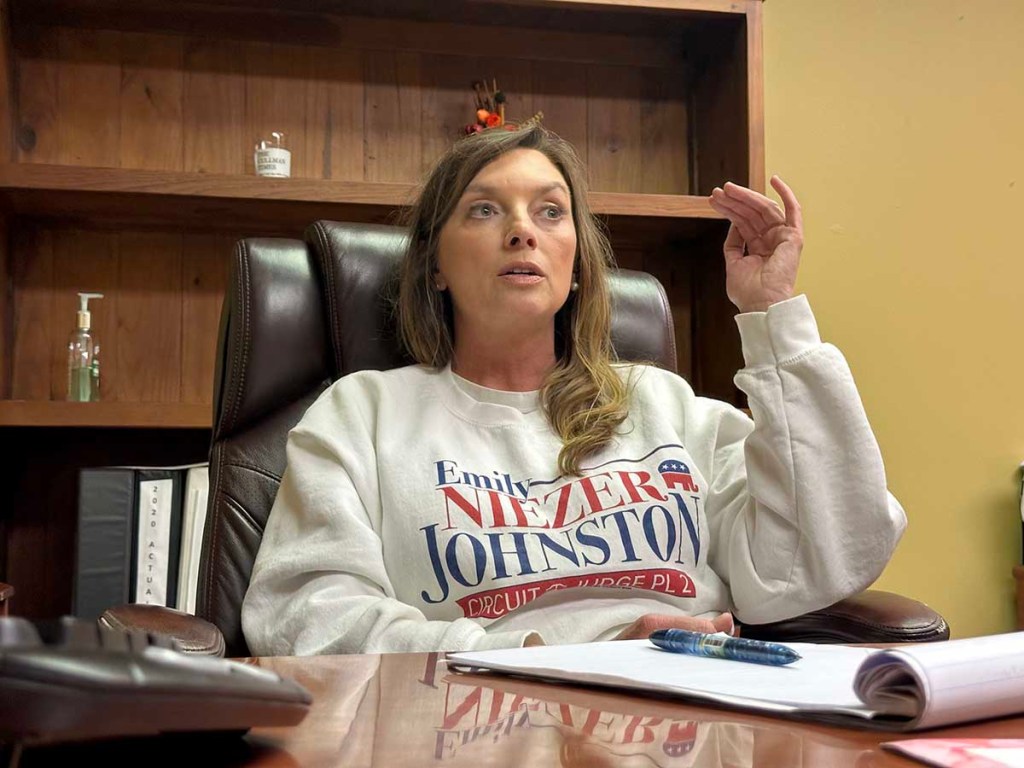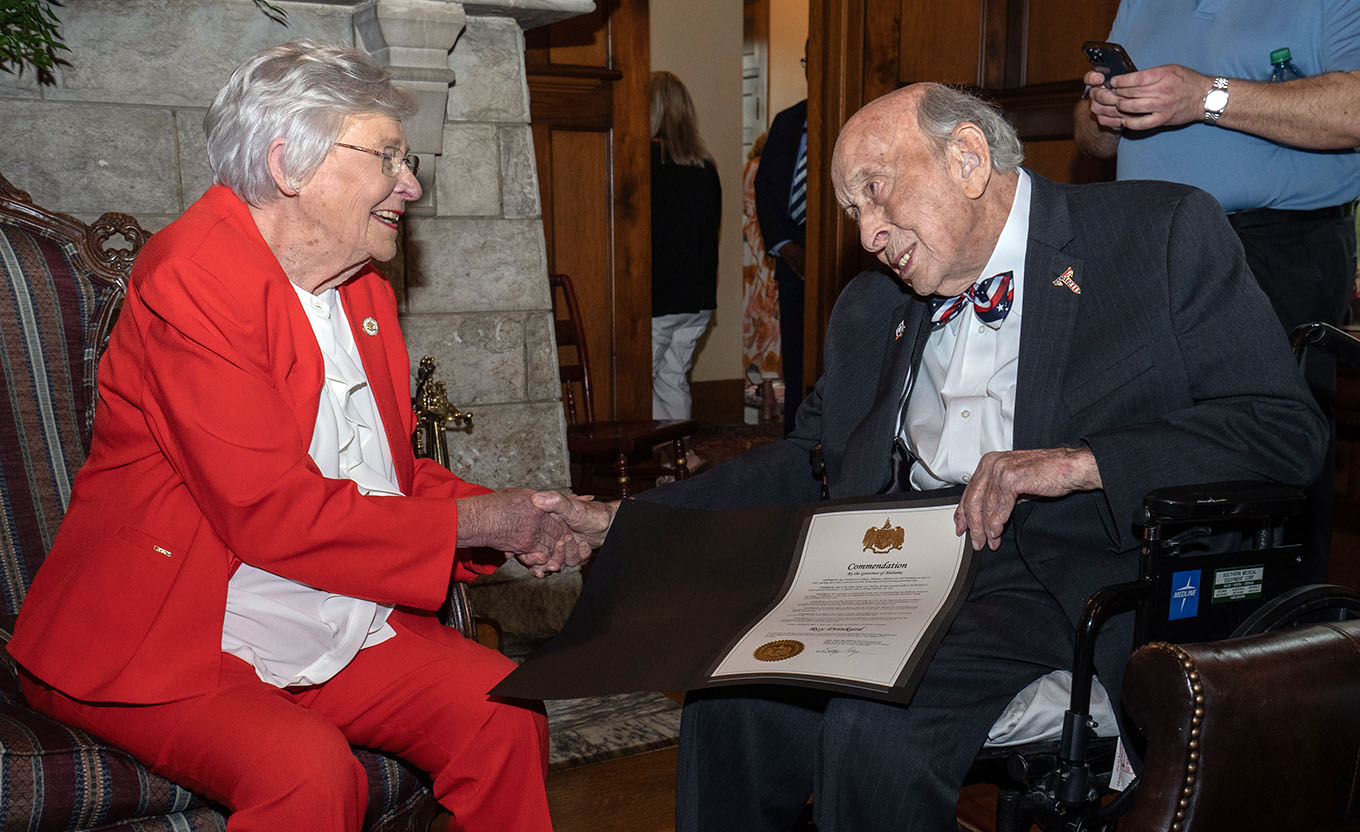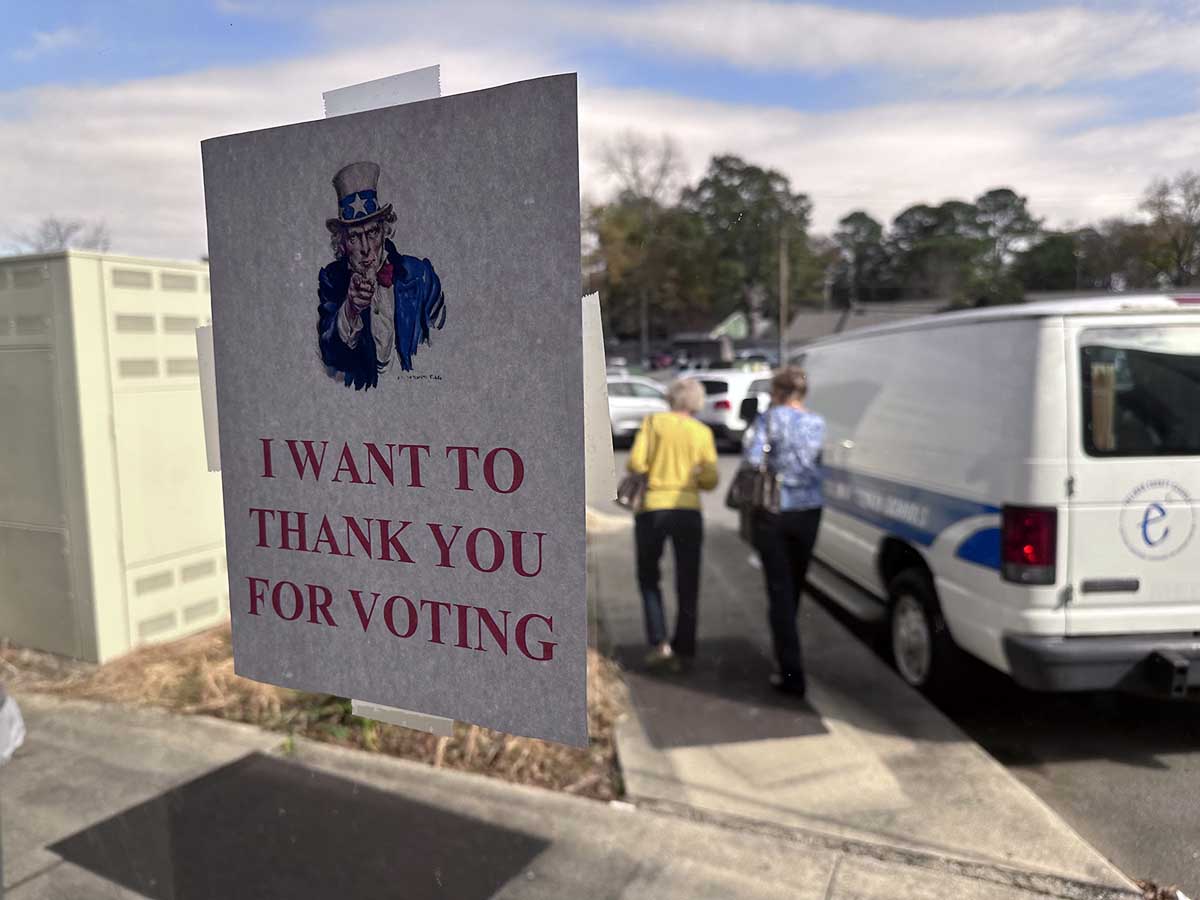Q&A: Emily Niezer Johnston
Published 12:15 am Thursday, February 29, 2024

- Emily Niezer Johnston is seen Tuesday, Feb. 27, at The Cullman Times.
Emily Niezer Johnston, attorney for the Cullman County Commission, is one of two candidates seeking election in the March 5 Republican Party primary for the position of circuit judge for Alabama’s 32nd Judicial Circuit — a circuit that concurrently encompasses Cullman County in its entirety.
Born and raised in Cullman County, Niezer Johnston is a 1992 graduate of Cullman High School, and holds degrees in political science and secondary education from Athens State University. After obtaining her juris doctor degree from Samford University’s Cumberland School of Law in 2001, she practiced law across Alabama, including private practice stops in Birmingham and as an assistant district attorney in Lee County, before returning to Cullman in 2006 and continuing in private law practice while also teaching at Wallace State Community College. She has served as county attorney since 2020.
Trending
Niezer Johnston recently visited with The Times to share her thoughts during a face-to-face question and answer session that explores some of the issues and ideas likely to confront judges of the court during the next elected judge’s six-year term. She will face local attorney Melvin Hasting for the judge’s seat in the upcoming Republican primary election on March 5. The winner of that race will face no additional opposition in the November General Election, and will be the presumptive elected successor to Cullman County Circuit Judge Martha Williams, who is not seeking reelection.
Niezer Johnston’s remarks below have been edited for brevity and for clarity.
CT: There’s experience, and then there’s temperament — two different, but important personal qualifiers that inform how a judge will approach their work. Characterize your qualifications in terms of both your experience and your temperament.
Niezer Johnston: When I was in law school at Cumberland, the school was highly rated, nationally, for trial advocacy. I competed in trial competitions there. Competing in that way led to my first job out of law school: I worked for a large firm where we handled cases all over Alabama. My trial advocacy teacher at Cumberland actually ended up hiring me away from that firm, and the largest client they had at that time was Walmart, so we did litigation all over the state. I’ve appeared in just about every circuit courtroom in Alabama at some point throughout my career.
From there, I went to the Lee County district attorney’s office. I’m thankful that Cullman does not have the type of crime that Lee County does — though that’s changing as we grow — but we had capital murder cases there on every single docket. There were a lot of drug cases as well; methamphetamine was kind of the prevailing drug at the time, and a lot of research and learning; a lot of experience, came through in preparing criminal cases for prosecution during that stretch of my career.
One of the things that you’re required to do as a judge is to have control of your courtroom. In that sense, you’re a referee to all the procedure that’s going on under your supervision. But in doing that, you have to keep a level head and to extend dignity to everyone who appears before the court, while appropriately and accurately directing all of that activity. A judge must do that while also making sure that everyone is fully informed: If you have a jury in the box, you have to make sure they are given the proper information and also the proper evidence that they’re allowed to hear. As a judge, you’ve got to have an even temperament and communicate well with everyone: The attorneys, the parties, the jury, the attorneys. It’s vital to do that in a way where everyone understands the “what” of what is happening, as well as the “why.”
Trending
You’ve also got to be consistent as a judge. You’ve got to be impartial, and you’ve got to allow both sides to have the opportunity to obtain the facts and to present their case. and behind the scenes, your temperament even extends into how you do the part of a judge’s job that doesn’t happen inside a courtroom: researching the law and understanding how to apply it. It takes will and kind of a consistent conscientiousness to always do those things when no one is watching, and I think — and certainly hope! — that my ongoing involvement in a number of different local nonprofit organizations reflects the authenticity of my genuine love for our community.
CT: ’Accountability’ courts like the drug court and veterans court introduce diversionary measures for defendants at risk of recidivism. Do you regard the current accountability court programs we have as effective, and if so, are there other community resources you might draw from, as a circuit judge, to expand these kinds of special court programs into new areas?
Niezer Johnston: You know, the accountability courts that we have — let’s take the drug court, which was established by Judge [Kim] Chaney, as an example — it has a high rate of success. It’s hard by design, though. It’s very difficult for a defendant to get through drug court, and for good reason: You’re being given a chance to have a felony dismissed, essentially, but there are a lot of hurdles you have to jump through and a lot you have to be accountable for to make it through. Veterans court is a little bit different, because there’s a mentorship aspect to it. In drug court, you’re required to go to classes and accomplish some things on the outside, while with veterans court, you have someone you can call upon when you need a little help or assistance.
I think our accountability courts are worth the investment that our judges and community have made in them. All of us — and I especially recognize this from my perspective working as the county attorney — need to keep all doors open. You’ve got to be willing to talk and engage with a lot of different potential community partners who may be out there with something to offer. I don’t want to insinuate in any way that I take a soft approach to crime, but I do think, especially for first-time offenders who aren’t violent or found to be a risk to the community, that it’s wonderful to have programs that can help people move past issues that may be contributing to their behavior. That’s really exemplified right now with the mental health court: Mental health is an enormous issue — and not just at the local level. I think, and I hope, that you’ll see a lot more resources going toward mental health moving forward.
CT: A significant case backlog is one of the biggest ongoing obstacles to the court’s efficient function, affecting all parties to a case and slowing justice for victims as well as the accused. What would you identify as current reasons that major felony cases can take so long to see trial or pleading, and how would you approach expediting them in a way that honors the Constitutional mission of the court and its obligation to all parties?
Niezer Johnston: I think COVID slowed a lot of things down. Four years later, I know people may be tired of hearing that. But however it came about, when you have such a large backlog, it’s hard to dig your way out of it. So you have to look at what’s causing it in the here and now. We’ve seen other recent changes that affect the court: There’s an election going on right now; we have a new district attorney. So we have to assess where we are right now and deal with what’s in front of us.
There are a lot of reasons for the backlog, and a lot of reasons why a case should be continued. The [state] department of forensics is backed up, and we of course can’t really control their speed. But there are other factors. For example, it doesn’t make sense to have a case tried if you don’t have your key witness available. If there’s a physician who’s critical to the case, and they aren’t going to be available on that date, it doesn’t make sense to commit everyone’s time and resources to trying a case that you know will be continued.
One of the more reasonable ways to approach it, I think, is to get all the parties involved — the attorneys, the DA’s office, the other judges, the circuit clerk’s office — and figure out together, “OK, how can we work together to bring these numbers down?” You can say all day long, “Hey, we’re just going to have back-to-back jury trials.” But you really can’t. I do think a reasonable option to look at is, if a case has been on the docket for a long time, find out why that is and address it specifically. and then start putting on the record why it’s been on the docket for so long. If it’s been continued three times and nobody can give you a good reason, put it on the record so that you can say, “You didn’t have your expert available at this time, so why don’t we specially set it? When is that person available?”
I think it will take time to find those kinds of things out, just because of the volume of cases that we have. But if a murder case, let’s say, is pending and it’s been pending for a long time, that kind of wait affects a lot of people and it affects them significantly. I think the oldest cases have got to be examined first. Perhaps you set a special docket just for those. But you’ve got to find a way to start moving those oldest cases first.
CT: On the criminal side, we don’t just have a case backlog; we have a bigger-picture issue with swiftness.
There is a number of statutory or Constitutional institutions, from law enforcement to the DA’s office to the court itself and then the penal system, that puts both defendants and victims in contact with the state — yet systemically, each of these units is often in functional tension with the others. Law enforcement catches accused criminals and jails them, the DA’s office can extend pending justice for the accused through an indefinite cycle of continuance motions, and courts are periodically compelled, by new mandates, to set free a significant number of defendants who actually do plead their guilt or are found guilty by trial — a result that puts the public at potential risk and creates understandable stress for their actual victims.
How can judges of the circuit court best work with these points of contact — and specifically, the people and personalities employed by the state and local points of contact that we have now — to expedite more just and more timely outcomes for both victims and defendants, including both the guilty and the innocent?
Niezer Johnston: That’s a question about the balance between the safety of the public and the constitutional rights of the accused, and really about how that’s affected by all the moving parts within the judicial system.
When I was the local bar president, one of the things I started was having lunches with the judges. Not everybody took that opportunity of course, but it was a way for attorneys to come and ask questions of the judges. One of the things that the attorneys asked was to have a list, from the sheriff’s office, of who was incarcerated at the time. Because as an attorney, you might not always know that your client even is incarcerated; you may be trying to locate them and have them show up in court.
In the big picture of what attorneys do, that was such a minor thing — and yet it really seems to have genuinely helped. Looking at that as an example, I think we’re capable of working out a lot of things if we just create opportunities to communicate; for the people who work in all of these different but connected areas simply to be able to talk. Open communication with everyone you work with goes a long way. Because even though we might fit into a different role in the judicial system, we all have a common goal, which is to serve our community.
CT: The current bench composition of this circuit means that whomever gets elected to succeed Judge Williams will very likely, at some point, become the next presiding judge of the circuit court. Talk about what that role entails, and how you would continue or change the administrative and operational guidelines that Judge Greg Nicholas, the current presiding judge, has instituted.
Niezer Johnston: That is an excellent question, but it’s one I would really want to consider more specifically once I’m actually in, or in a position to closely observe, the presiding judge in their role. It is a lot of extra work for whomever is in that position, and if you look at it going farther back, judges [Don] Hardeman and [Frank] Brunner used to swap that role back and forth. Judge Nicholas has been the presiding judge for a long time, and from talking with him, I know that he has always been attentive to the other judges’ needs, and to their input on how to make the court run smoothly.
CT: There’s far more to the role of circuit judge than the ground we’ve briefly covered here. Offer an answer to a question you would like to have been asked that we haven’t touched on, but that touches on a topic you feel is significant as a potential future judge for the 32nd Judicial Circuit.
Niezer Johnston: As I’ve campaigned and spoken with people in our community, so many of them want to know: “How tough are you going to be on crime?”
My dad was a prosecutor; I’m a former prosecutor. So protecting the community where I live; where I grew up, is already important for me. If someone’s convicted of a crime, I’m going to do everything I can within the law to make sure that the people of our community are safe. At the same time, a judge has a constitutional obligation to protect the rights of everyone who comes before the court, and that does include the accused. But, whether it’s as a circuit judge or simply as a Cullman County resident, the safety of our community is, and always will be, my number-one priority.





